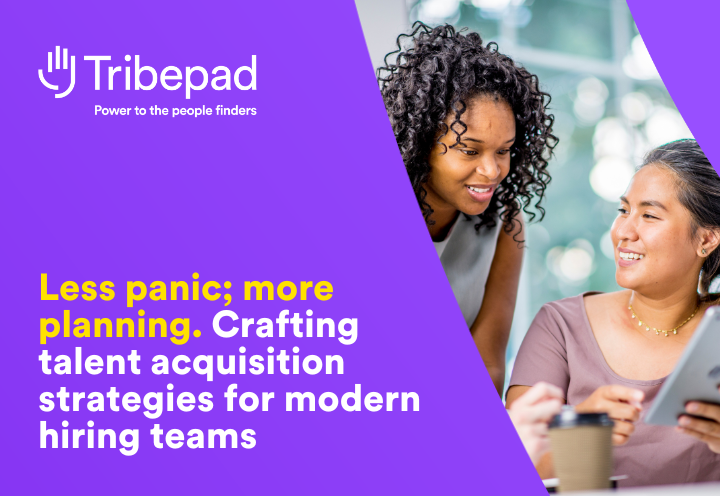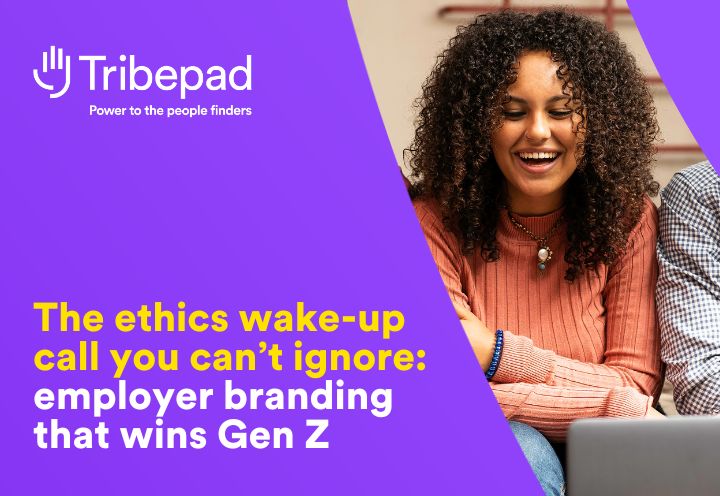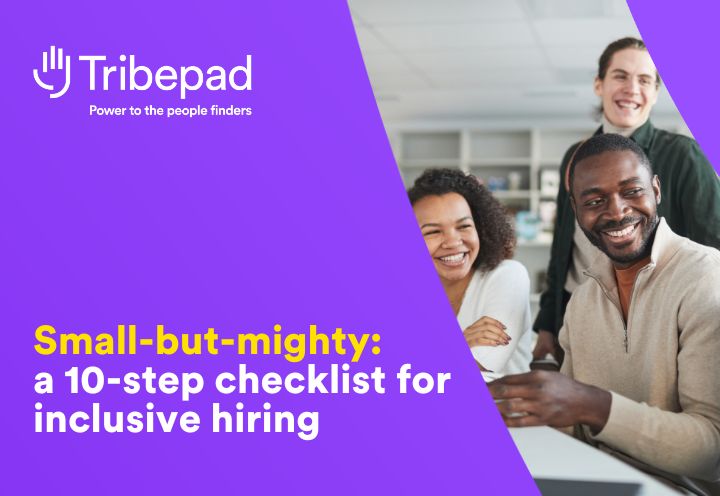The talent acquisition vs. recruitment debate might seem like semantics. But underneath the words, there’s a more fundamental question around the way hiring works – and its value and perception – within the organisation. Is hiring a cost-centre? Or a strategic lever for business success?
There isn’t clear sea between the terms recruitment and talent acquisition, so they’re often used interchangeably.
Your department might be called “talent acquisition” but be stuck in a recruitment mindset. Or equally, you might be a “recruiter” but actually work in alignment with the goals, strategy, and approach of talent acquisition. Or you might do elements of both.
Underneath the terms lies a whole framework for how your organisation approaches hiring. And views the hiring function.
Let’s talk about that. So you get a better sense of how to move towards higher-impact hiring. (Whatever your team’s currently called).
A comparison of talent acquisition vs. recruitment
What’s the difference between talent acquisition and recruitment?
Talent acquisition |
Recruitment |
|
|
|
|
|
|
|
|
In a nutshell, talent acquisition is more concerned with building a workforce that meets the organisation’s strategic needs long-term. While recruitment is more concerned with filling current vacancies.
You can see why the terms get blurred – both talent acquisition and recruitment are fundamentally about hiring. They both involve attracting, sourcing, and engaging with candidates. They both require assessment and selection. They both result in bringing talent into the organisation. They both rely on the same core tools.
But the emphasis is fundamentally different. Let’s look more closely at what TA and recruitment actually involve on a day-to-day basis.
What does talent acquisition vs. recruitment involve?
The bread and butter of recruitment is:
- Scoping the role. Working with managers; taking briefs; crafting job ads that don’t put candidates to sleep.
- Shouting from the rooftops. Distributing ads to job boards, social media, and internally. Wherever your people hang out.
- Shortlisting fast. Screening applications, collab-ing with managers, collating feedback and progressing candidates ASAP.
- Running the show. Organising interviews, corralling managers, chasing feedback, keeping everyone in the loop (no ghosting allowed!)
- Sealing the deal. Issuing offers, sorting paperwork, handling compliance checks, and teeing up Day 1 so hires hit the ground running.
Many of the tasks are the same for talent acquisition but with added emphasis on bigger picture, longer-term stuff, like:
- Planning ahead. Forecasting future headcount and skills needs. Hiring more strategically around where the business wants to be, not where it is.
- Employer branding. Crafting a great EVP and consistent, compelling Employer Branding that attracts the right people to your door.
- Recruitment marketing. Running always-on sourcing and marketing campaigns to build your brand and attract talent.
- Growing pipelines. Creating talent pools of top talent around future needs. So you’ve got people good to go when you need them.
- Managing relationships. Using a talent CRM, TA involves engaging and nurturing talent, to keep relationships “warm”.
- Harnessing hiring data. Understanding your important KPIs, yes. But turning hiring data into board-level insight. Steering strategy with facts, not hunches.
- Championing mobility and inclusion. Designing hiring journeys that are fair for everyone. Unlocking diversity at every layer of the organisation.
- Sweating strategy. Seeing the wood through the trees. Considering strategic priorities to build a long-term hiring function that’s higher-impact.
Is talent acquisition “better” than recruitment?
Recruitment isn’t “bad”. Sometimes you absolutely need to bring people into the business to fulfil immediate hiring needs. And being great at doing that efficiently and effectively is a real asset.
There are plenty of roles and industries that suit a recruitment-led approach.
When recruitment makes sense
Recruitment is good when you need to fill well-defined roles fast and cheaply, and when future demand is uncertain or low-complexity. Recruitment tends to work well when:
- The job expectations (on both sides) are clear and standardised, so you can advertise, source, screen, and assess in a formulaic way. Like… customer-service advisors, retail associates, delivery drivers, care assistants.
- The organisation feels every day a seat stays empty, so time-to-hire matters enormously. A lean, vacancy-led process gets “bums on seats” where they’re desperately needed. Like… replacing a barista who quit; ramping up a call centre for a holiday spike.
- Roles are high volume and have comparatively low lifetime value to the organisation, so the extra spend on strategic talent acquisition activity isn’t justified. Like… high-volume food-service roles or seasonal retail contracts.
- You’re not sure you’ll need many more of this role. Or growth depends on short-term factors, so it’s inherently unpredictable. Strategic activity could become a sunk cost if demand drops. Like… construction project crews, or early-stage start-ups iterating their product.
- You’re not struggling to hire who you need. Skills are common, ramp-up is short, and candidates are plenty. There’s no push to hire more strategically because what you’re doing works fine. Like… many high-volume entry-level roles traditionally fit this criteria. But skills shortages add complexity.
Benefits of a recruitment approach
Recruitment has some advantages over talent acquisition. (Or at least, some theoretical advantages that an optimised recruitment function can deliver).
Like:
- It’s faster. Recruitment tends towards focussed, short-cycle hiring drives, getting the people you need now where you need them.
- It’s cost-effective. Leaner processes, less recruiter overhead, and fewer “nice-to-have” steps keep recruitment costs down.
- It’s easy to measure. If you’re focussing on recruitment, you’ve probably looking at straightforward standardised KPIs like time-to-hire and fill rate.
- It’s agile. If you’re recruiting, you can spin hiring campaigns up and down fast as headcount needs shift. Yes, it’s more reactive. But it’s also more flexible.
Recruitment does have clear uses and value. But that said, complexities in the market – skills shortages; AI-enabled candidates; high competition; fast-changing skills needs – mean many organisations are moving more towards a talent acquisition hiring approach.
When talent acquisition makes sense
Talent acquisition is often the right play when talent is pivotal to growth, scarce, predictably recurring, or value-critical. (AKA: the organisation can’t afford to start from scratch whenever there’s a hiring need).
- Roles are business-critical, hard-to-fill, or evolving fast. So you need time to woo passive talent, build relationships, and assess for future-fit skills. Like… senior software engineers for a new AI product; neonatal nurses in an area with nursing shortages; C-suite leaders.
- You can reliably predict ongoing demand—growth plans, expansion roadmaps, or regular back-fills. So pipelining talent now saves major downtime later. Like… a retailer opening 10 new stores next year; a consultancy that onboards a fresh analyst cohort every quarter; a call centre with high churn.
- The cost of unfilled roles (or a bad hire) is huge because the role drives revenue, innovation, compliance, or customer trust. Investing upstream is cheaper than firefighting downstream. Like… sales directors with high-value quotas; cyber-security leads guarding sensitive data.
- Employer brand and candidate experience are major plays in a competitive talent market. So every interaction is part of a long game to attract, convert, and retain hard-won talent. Like… tech scale-ups competing with Big Tech; healthcare providers differentiating on patient-first culture.
- DEI goals are forefront. DEI progress demands deliberate outreach and nurture, not last-minute scrambling. Like… engineering firms aiming to double female hires within three years; public sector organisations improving representation.
- Skills are scarce, specialised, or emerging so the talent pool is small and often passive. Relationship-led sourcing, CRM, and skills-based hiring beats “spray and pray” job ads. Like… senior pulmonologists, green electricity engineers, or bilingual social-media strategists.
- The C-suite expects workforce insights and hiring forecasts to guide strategic decisions, like launches, M&A, or territory expansions. Like… modelling skills gaps before entering an emerging market or ahead of a digital transformation.
Benefits of a talent acquisition approach
Where recruitment is a shorter-term value driver, talent acquisition is a strategic growth-enabler. Some of the major benefits of talent acquisition over recruitment:
- It delivers a predictable talent pipeline. When hiring’s hard, talent acquisition relies on always-on sourcing and CRM to keep pipelines full.
- It improves quality of hire. Building relationships over time reduces emergency compromises (“they’re not great but they’re all we’ve got”). Which drives stronger performance, less churn, and faster time-to-productivity.
- It turns your EB into a valuable asset. Consistent storytelling makes your organisation magnetic to top talent. And there’s a halo effect for all your roles, even the slam-dunk recruit-on-the-spot positions.
- It builds future-ready skills. A longer-term, strategic approach to hiring means you can prepare for tomorrow’s skills needs. Giving you more resilience to skills shortages and a sharper competitive edge.
- It drives DEI progress. Strategic talent acquisition can surface overlooked “radical talent”, progressing representation targets (and locking-in the business benefits of diversity).
- It fuels data-driven hiring. Strategic TA tends to capture more, better data, then actively and continuously use that data to improve. Better data means better hiring.
- It’s more financially sustainable. Initial investment in talent acquisition is higher than recruitment, but long-term you save. Less time spent attracting; less time reinventing the wheel; less agency reliance; less rehiring.
- It builds credibility and trust with stakeholders. With talent acquisition, you become a strategic advisor delivering long-term value. Managers see fewer delays and better candidates. Leadership sees better hiring outcomes, consistently evidenced.
Although recruitment and talent acquisition both have their place, most organisations aspire to move towards talent acquisition. Or, at least, to incorporate elements of the talent acquisition approach into their hiring function.
So, no. Recruitment isn’t “bad”. But if you only recruit instead of also taking a longer-term, more proactive approach to talent acquisition, you’re likely stuck with some major pains.
The case for blending talent acquisition and recruitment
If you only recruit reactively, you’re probably in a world of pain:
- No pipeline means every role starts from zero. HR scrambles; managers shoulder extra workload; projects stall.
- You’re more likely to hire badly. Recruitment pressure forces compromise on skills and fit. Compromises that the organisation pays for long-term.
- You’re stuck watching skills gaps emerge, not evolving. The organisation can’t upskill easily, which hampers innovation and agility.
- Your employer brand and CX get progressively worse. Reactive firefighting often translates into clunky candidate journeys and ghosting.
- Recruitment costs keep increasing. Recruitment might seem cheaper and faster. But those costs are increasing steadily, with no valve to decrease.
On the other hand, going all-in on talent acquisition can also create pain:
- Vacancies pile up while you perfect strategy. Talent acquisition thrives on long-term planning, but short-term realities often throw curveballs. If you don’t have a “fast lane” for urgent hires, high-priority roles risk sitting empty.
- Upfront costs are high before pay-off. Talent acquisition takes time and money, and the ROI won’t be immediate. If you put all your eggs in the TA basket, you risk writing cheques your delivery can’t cash.
- Risking credibility. If senior leaders are used to reactive recruitment against short-term quantifiable goals, TA tasks might seem like busy-work and bumf. Keeping one foot in the recruitment camp can buy time to fight scepticism.
- Over-complicating hiring. Not every hire needs six months’ courtship before signing on the dotted line. Treating high-volume, low-complexity positions like niche strategic hires bloats TTH and frustrates managers.
For most organisations, the sweet spot is probably a blended model – at least while you transition. Keep a lean, rapid-response recruitment engine for today’s roles, while building a strategic TA layer for tomorrow.
That way, you can protect short-term delivery while also building for future growth. Without the costs of leaning too far in either direction. So… how?
How to evolve towards talent acquisition
Moving from a role-by-role scramble to a forward-looking talent engine doesn’t happen overnight. But it’s easier than you think to integrate bite-size elements of strategic hiring and start evolving your hiring function. Whatever you call it.
- Get your house in order. Audit your recruitment data so you know where the pain (and the quick wins) really sit. Spot the 20% of change that’ll drive 80% of impact.
- Automate everything automatable. Your recruitment software should automate all the boring, repetitive, this-doesn’t-need-a-human bits. Reclaim your time, so you can do more of the peopley stuff.
- Protect the “now” while you build the “next”. Keep recruitment workflows humming for high-volume roles but ring-fence bandwidth for strategic hiring projects.
- Start building talent pools. You needn’t start huge. Choose a focus area then tag critical skills, line up silver medallists, and contact previous talent. Then watch buy-in build as teams notice the difference.
- Layer on employer branding activity. Start creating some basic EB content. It doesn’t need to be extravagant. Could you craft some short employee-led videos about your culture, say?
- Run a recruitment marketing campaign. Pick one role and run an active recruitment marketing campaign to evangelise this model of hiring. (Here’s a fantastic example from Richmond and Wandsworth).
- Seek strategic conversations. If people finders want a seat at the table, you’ll have to take it. Talk to leaders about how hiring can contribute to business outcomes. Then start moving the needle on initiatives that align.
- Iterate, don’t wait. Pilot new ideas (like, say, video screening or anonymous applications) in one function. Prove value then roll out at pace. Seize the initiative: deliver orders; don’t take them.
“TA” or “recruitment”, let’s focus on high-value hiring
Whatever your function’s called. Whatever your job title. Whether you’re a team of 30 or a team-of-one. Those things don’t matter as much as the impact you deliver.
Being more strategic; more proactive; more front-footed; more efficient – those things help you build a hiring function that’s more successful longer-term. Whether you call that “talent acquisition” or “recruitment”, that’s what high-impact hiring is all about.
Meet your biggest recruitment allies
Tribepad is the trusted tech ally to smart(er) recruiters everywhere. Our talent acquisition software is a springboard for fairer, faster, better recruitment for everyone.
In just 30 minutes we can help understand your business and your biggest challenges, and see whether Tribepad could help you solve some of your biggest hiring headaches.




